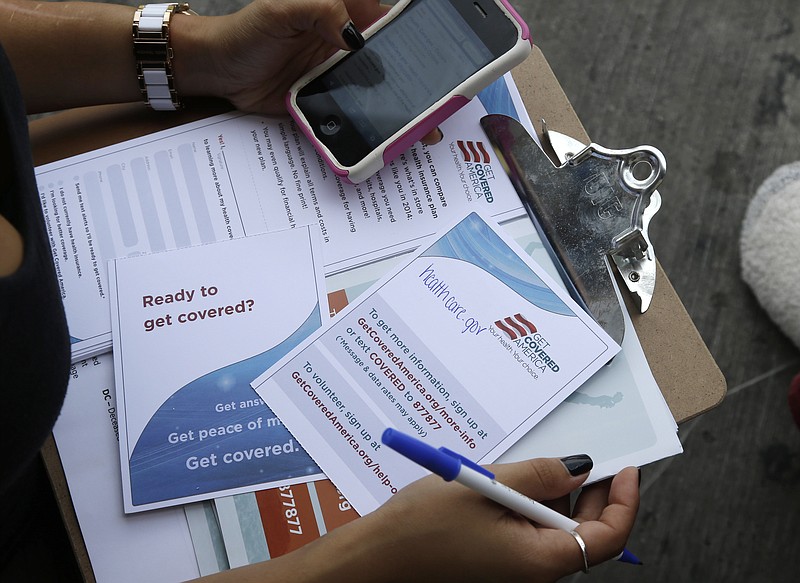We who volunteered to be on the board all believed in the concept and thought it would be helpful to the citizens of Tennessee. Were very, very sorry it came down the way it did.
The announcement last week that Tennessee's only health insurance cooperative would close its doors leaves thousands of consumers statewide looking for another insurer and raises questions about how much - if any - of the $73 million the federal government loaned to the co-op will be paid back.
That cooperative, the Community Health Alliance, is not the only one in trouble. Of the initial 23 cooperatives - federally funded insurers established under the Affordable Care Act to give competition to established private health insurers - nine have folded and several more are in trouble.
Twenty-one out of 23 reported losses last year, although some of the losses were expected, according to an audit released in July by the inspector general for the U.S. Department of Health and Human Services. Eight had fewer than a quarter of the customers they'd anticipated signing up - including Community Health Alliance, which projected it would have 25,000 enrollees by the end of 2014. It ended up with only 1,588, according to the audit.
Were co-ops a bad idea in the first place?
How much of the $2.4 billion loaned to the co-ops so far will taxpayers lose?
Without co-ops, will a handful of private insurance companies dominate most state markets, keeping prices high?
And in the case of Community Health Alliance, was its downfall due to factors beyond its control, or bad management decisions made at its Knoxville headquarters?
***
At its most basic, how insurance works seems simple - an insurer gets enough people to pay a premium that will cover the medical expenses of everyone in that pool. Insurers do that using "actuarial tables" that estimate how many people in a certain income or age group are likely to get sick or be injured in a year.
In certain specialties, such as auto insurance, years of data are available, for example, on how many 17-year-olds are likely to be in an auto accident in a year and the average cost of their repairs. It is not that hard for an insurer to count up the number of 17-year-olds it is insuring and calculate how much to charge to cover their expected repair bills.
That is harder to do in health insurance, because there are many more ways for people to be sick or injured - and the medical costs can vary widely.
The Affordable Care Act, commonly called Obamacare, was designed to provide health insurance coverage to people who did not have it previously, either because of a pre-existing illness or because it was too expensive. A key issue from the outset was figuring out who these people were and how their medical claims would compare to the people already covered.
Another unknown was the response of healthy young people toward purchasing the insurance. A lot of them had not bought insurance because they didn't believe they needed it. They faced a modest penalty, at first, if they didn't sign up. The penalty was a lot lower than the cost of health insurance.
With all of the uncertainties, federal officials were concerned that many insurance companies would not participate in the ACA at all, or that only one or two would participate in each state, establishing a monopoly. To counter their fears, the ACA promised reimbursements in the first few years if private insurers lost money.
And to guard against monopolies, health officials proposed a nonprofit, government-funded insurer that eventually would be able to stand on its own.
Thus came the establishments of health insurance cooperatives, similar to credit unions or farm co-ops. They would be run by their own members instead of the government, and the hope was that they would be established in every state.
Government loans were made to nonprofit groups that would provide health insurance at what was hoped would be competitive rates. Nationally, 23 co-ops were formed, including the Knoxville-based Community Health Alliance, formed to serve all of Tennessee.
Community Health Alliance seemed to have a veteran management team. CEO Jerry Burgess had held senior executive positions with St. Mary's Health System of Knoxville, Christ Hospital of Cincinnati and Methodist Health Systems of Memphis. Chief operating officer Judy Slagle spent years in top manager positions at BlueCross BlueShield, and chief financial officer David Young claimed 22 years of health care accounting and finance experience.
Those same managers also started a sister co-op in South Carolina, the Consumers' Choice Health Plan.
In 2014, its first year, Community Health Alliance had little success in luring customers.
BlueCross BlueShield dominated the market, with a 70 percent share. But in 2015, BlueCross BlueShield raised its rates and Community Health Alliance found itself as the lowest-cost provider. By Jan. 15 of this year, it had reached its subscriber goal of 25,000 subscribers. But while signups soared, the Community Health Alliance was bleeding money from the year before. That same month, it met with state insurance regulators and agreed to stop enrolling more participants.
"They came to us, and we worked with them through that process," said Kevin Walters, communications director for Tennessee's Department of Commerce and Insurance.
The co-op was experiencing problems typical for startups - its complicated computer system was a mess, according to a review this summer by the U.S. Centers for Medicare and Medicaid Services, the federal agency that oversees Medicaid and Medicare. Officials reported a high level of complaints from both consumers and providers.
In its first year, the Community Health Alliance had projected that it would lose $8.6 million. Instead it lost $22 million.
And it underestimated its customers' medical needs, paying out $8.6 million in claims while only collecting $6.6 million in premiums.
The co-op's problems were not unique, however. Nationally, 19 of the 23 co-ops paid more in claims than they collected in premiums in 2014.
But the Health Alliance had other problems. In a strongly worded letter dated Sept. 19, officials questioned the co-op's financial viability, its ongoing problems, and expressed concern over how the Tennessee co-op split some of its expenses with its sister co-op in South Carolina. The co-op was placed under an "Enhanced Oversight Plan" and required to submit weekly reports to the Centers for Medicare and Medicaid Services.
There is no way to determine if the Community Health Alliance could have survived those problems, however. A surprise announcement from Washington sealed its fate only days after the CMS letter.
***
It wasn't just the co-ops that were having problems with the Affordable Care Act.
BlueCross BlueShield dominated the market in Tennessee, but misjudged its costs and revenue for the ACA and lost $141 million in 2014.
For more information
Community Health Alliance policyholders who have questions should contact the Tennessee Department of Commerce and Insurance Director of Consumer Insurance Services, Vickie Trice, at 615-741-2218, 1-800-342-4029 or by email at cis.complaints@tn.gov.
Federal health officials had anticipated some of those losses, and to ensure that insurance companies stayed in the program, the ACA provided guarantees that they would initially share the risk. For the first few years, insurance companies that made money would share some of their revenue with companies that did not, through several different programs. One of them, known as "risk corridors," is having an impact far from what its designers intended.
The "risk corridor" program provided that insurers who made more than a certain percentage of profit would pay a portion of that money, between 20 and 50 percent, back to the Department of Health and Human Services, which would then use it to cover the losses of insurance companies that failed to make a profit. Initially, Health and Human Services believed it could use funds from other programs to fund any shortfalls from the risk corridor reimbursements, and the General Accounting Office agreed. So health insurers and co-ops made their 2015 budgets to include full reimbursement for their losses covered by risk corridor payments.
But this year, as part of a budget bill, Congress suddenly changed horses. It stated that the plan had to be revenue neutral - the amount of money that could be paid to the insurance companies that lost money could be no greater than the amount put into the payment pool by those who made money. Since most of the insurance companies and co-ops underestimated how much they would pay out in medical bills, the losses totaled $2.87 billion while the excess income to help cover those losses amounted to only $362 million, only a portion of which would go for reimbursements.
When the government announced earlier this month that the risk corridor payments would cover only 12.6 percent of their losses, there were howls of outrage, and five co-ops, including Tennessee's Community Health Alliance, promptly went out of business.
The head of Oregon co-op Health Republic told the Portland Business Journal on Oct. 16 how the reimbursement surprise had forced her firm to close: "Let's be clear here. Health Republic, as well as every other co-op that has gone down, is purely collateral damage to a dysfunctional political system and government." Co-ops in Colorado and Kentucky also announced that the low reimbursements would force them out of business.
Without a full reimbursement, the Health Alliance had little choice but to close. It did not meet the minimum funding required by state insurance regulators.
"We expected 100 percent [reimbursement]," said former Health Alliance board chairman Ronald Braam. "That made it pretty hard to continue."
Community Health Alliance called it quits.
The risk corridor news "led to an unavoidable outcome," CEO Burgess said in a statement posted on CHA's web site.
Two weeks later, the sister co-op in South Carolina announced it was following suit, citing the low-risk corridor reimbursement.
Will the U.S. government recover any of the $73 million it loaned to Community Health Alliance?
Probably not, according to Mike Adelberg, who managed the co-op program for Health and Human Services before leaving six months ago to become a consultant for FaegreBD Consulting.
State insurance regulators will determine the priorities for using any remaining money.
"It is probable that making members whole and paying provider claims will be a higher priority than paying off the federal loans," Adelberg said.
Critics of the co-ops say they were never a good idea. If insurance companies with years of experience were losing money, why was Congress loaning billions to startups with no name recognition and little idea how sick their customers might be?
Supporters say co-ops were hobbled from the outset and further crippled by changes in policies.
Co-ops were not allowed to use any of their government loan money to market their services - a major handicap for companies with no name recognition competing against well-established firms such as BlueCross, Humana and Cigna.
That "makes no sense, to tie a hand behind your back like that," said Health Alliance's Braam.
Initially, the plan was for the co-ops to receive millions in federal grants, but those were then changed into loans, with relatively short payback periods. Congress originally discussed spending $10 billion, then authorized lending $6.4 billion, cut that to $3.4 billion and further reduced that as part of a budget deal in 2013 to what had actually been spent plus 10 percent, about $2.4 billion.
The Community Health Alliance's failure won't immediately affect the 35,000 enrollees it reported as of mid-May. They will still have insurance coverage through the end of the year, but then they will need to find a new provider.
With the Health Alliance out of the picture, BlueCross, Cigna, Humana and UnitedHealthcare will compete for Tennesseans' health insurance business. BlueCross has been dominant thus far, but UnitedHealthcare is a new arrival - a well-funded competitor. Whether the end of the open enrollment period leaves one insurer with a near-monopoly remains to be seen. But with the Community Health Alliance out of action, there are no consumer-run nonprofit organizations in the field.
Nationally, the next year may be crucial in determining whether cooperatives were a good or bad idea.
While nine have failed, a handful seem to be in good shape. They will have two years of data on which to base their policies, although some of the temporary subsidies offered under the ACA will begin to run out. Are they doing what they were set up to do, offering competition to the big health care insurers? Or will they end up as a multi-billion dollar failure, yet another example of how difficult it is to provide good health care while keeping costs under control?
"Anywhere in the American economy, startups fail," said former HHS co-op supervisor Adelberg. "When the dust settles the co-ops will be on a continuum from successful to failed. The next couple of years will tell us which end of the continuum most of them end up on."
Former Community Health Alliance board chairman Braam had a more personal take.
"We who volunteered to be on the board all believed in the concept and thought it would be helpful to the citizens of Tennessee," he said. "We're very, very sorry it came down the way it did."
Contact staff reporter Steve Johnson at sjohnson@timesfreepress.com, 423-757-6673, on Twitter @stevejohnsonTFP or on Facebook at stevejohnsonTFP.


